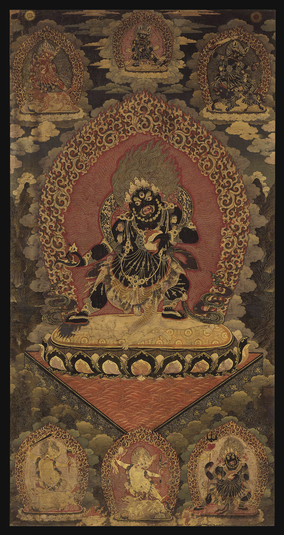
Item: Yama Dharmaraja (Buddhist Protector) - Inner
| Origin Location | China |
|---|---|
| Date Range | 1700 - 1799 |
| Lineages | Gelug and Buddhist |
| Material | Ground Mineral Pigment on Cotton |
| Collection | Private |
Classification: Deity
Appearance: Wrathful
Gender: Male
Inner Yama Dharmaraja, (Tibetan: shin je cho gyal nang wa. English: Inner Lord of Death, King of the Law). Dharmaraja is the special protector for the Vajrabhairava cycle of Tantric practices and is especially associated with the Rwa Lotsawa Tradition.
At the top center is Heruka Vajrabhairava with one face and two hands. To the left is red 'Powerful Activity' Yamaraja holding a wishing jewel and a skullcup to the heart. To the right side is blue-black 'Wrathful Activity' Yamaraja holding a bone stick and a lasso. At the bottom center is white 'Peaceful Activity' Yamaraja with two hands, holding a damaru drum and a divination arrow with the left. To the left is yellow 'Increasing Activity' Yamaraja holding a sword and banner. Each of the Yamas has a buffalo head, adorned with various wrathful ornaments and stands upon a buffalo of similar colour, above a corpse, sun disc and lotus surrounded by the flames of pristine awareness.
Indian Lineage: Vajradhara, Shri Vajrabhairava, Jnana Dakini, Lalitavajra, Vajrasana, Amoghavajra, Jnana Sambhava Bepa, Padmavajra, Dipamkara Shrijnana, (the Nepali) Bharo Chag Dum, (the Tibetan) Ra Lotsawa Dorje Drag, etc.
"In the special, noble, Vajra Vehicle, among the numerous four tantras [kriya, charya, yoga and anuttara] this protector is of the Anuttarayoga. Of those, from the three [classes], Method, Wisdom and Non-dual, this is Method Tantra. From the three famous Father Tantras of the Yamari Cycle, Rakta [Red], Krishna [Black], and Bhairava [Terrifying], this is the uncommon protector of the Vajrabhairava." (Ngor Ponlop Ngagwang Legdrub, 19th century).
The words Yama, Yamantaka and Bhairava appear frequently in all four classes of tantra as attendant deities, protectors or as worldly gods (specifically Shiva) beneath the feet of meditational deities (ishtadevata) such as Vajrayogini and in this instance represent the various negative emotions to be conquered through meditation. It is important not to confuse all of these various models and to understand each in its own place.
Jeff Watt 9-2017
Buddhist Protector: Yama Dharmaraja Art History
Buddhist Protector: Yama Dharmaraja Main Page
Painting Style: Qianlong Period Painting Style
Buddhist Protector: Yama Dharmaraja, Inner
Buddhist Protector: Yama Dharmaraja (All Forms Masterworks)
Collection: Sotheby's Hong Kong (Painting & Sculpture. October, 2017)
Buddhist Protector: Yama Dharmaraja ('Inner' Masterworks)

